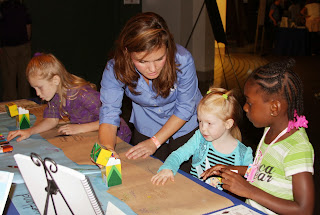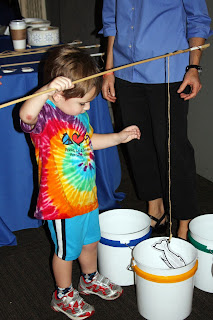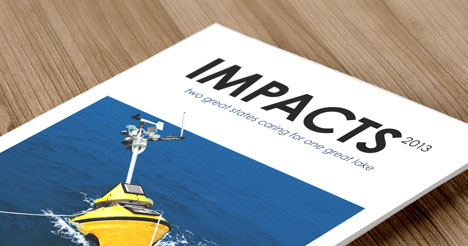August 20th, 2014 by iisg_superadmin
You have probably heard that pharmaceuticals have been found in rivers and streams, groundwater, and drinking water throughout the country, in part because medications are sometimes flushed down the toilet or thrown in the trash. While the contamination levels are not yet proven to pose health threats to people, studies have shown that these chemicals are have been linked to impaired development, behavior, and reproduction in aquatic wildlife.
In 2013, Illinois-Indiana Sea Grant, which has been a leader in addressing the need for safe medicine disposal, provided assistance to 39 permanent collection programs in both states. IISG also supported single-day collection events in 14 communities by assisting with the collections, writing press releases, and providing educational materials.
As a result, 12,040 pounds of medicine were properly disposed of through permanent collection programs and single-day events supported by IISG. The medicine was destroyed using high-heat incineration, thus reducing the potential for diversion or accidental poisonings and keeping the chemicals out of local water.
To learn more about how IISG is empowering communities and individuals to secure a healthy environment, check out our 2013 program impacts.
August 6th, 2014 by iisg_superadmin
Steve Mauro’s research into the impacts of pharmaceutical and personal care products (PPCPs) on bacterial communities may have started as a small side project, but it has become so much more. The Gannon University dean gained national attention in 2011 when he and his research team discovered that small concentrations of fluoxetine are killing E. coli in the nearshore waters of Lake Erie. Today, Mauro continues to investigate exactly where and how fluoxetine and other pharmaceutical chemicals, both individually and combined, are changing the microbes that keep aquatic ecosystems healthy. And it is this work that brought IISG to his office bright and early on a June morning.
In this issue of UpClose, Mauro goes beyond his work on PPCPs to talk about the importance public outreach and about new efforts that are making it easier for forecasters and beach managers to predict when E. coli levels may make a trip to the beach more trouble than its worth.
June 19th, 2014 by iisg_superadmin
 The APEX awards are given each year by Communication Concepts to recognize outstanding publication work in a variety of fields, and Illinois-Indiana Sea Grant projects were selected this year for awards in two categories.
The APEX awards are given each year by Communication Concepts to recognize outstanding publication work in a variety of fields, and Illinois-Indiana Sea Grant projects were selected this year for awards in two categories.
Laura Kammin and Anjanette Riley of our Unwanted Meds program received an award in the category of Green Writing for their edition of UpClose with researcher Rebecca Klaper. The UpClose series interviews professionals working in the pollution and water quality fields to learn about the latest discoveries and projects related to pharmaceuticals and personal care products.
 Additionally, Sarah Zack, Pat Charlebois, and Jason Brown were awarded in the Green Campaigns, Programs & Plans category for their work on our “Be A Hero – Transport Zero” campaign and messaging, and for the www.TransportZero.org website. The campaign is designed to show boaters, fishermen, and other recreational water users how simple it can be to help prevent the spread of aquatic invasive species between water bodies.
Additionally, Sarah Zack, Pat Charlebois, and Jason Brown were awarded in the Green Campaigns, Programs & Plans category for their work on our “Be A Hero – Transport Zero” campaign and messaging, and for the www.TransportZero.org website. The campaign is designed to show boaters, fishermen, and other recreational water users how simple it can be to help prevent the spread of aquatic invasive species between water bodies.
These projects are just two of the many that IISG continues working on to help the public learn about, protect, and preserve Lake Michigan and waterways throughout the two states. To learn more, visit our website.
May 21st, 2014 by iisg_superadmin
It has been nearly one year since IISG set sail on Lake Michigan to sample for plastic pollution. Since then, Sam Mason, a chemist from State University of New York Fredonia, and her research team have been hard at work analyzing those water samples. The initial results are revealed in the latest edition of IISG’s interview series UpClose.
In this issue, Mason talks about her ongoing work to quantify plastic pollution in the Great Lakes for the first time. In addition to the Lake Michigan results, Mason discusses plastic levels in the other four lakes, explains how plastics could impact aquatic wildlife, and suggests additional research needed to understand this emerging contaminant.
This is the sixth edition of UpClose, which takes readers behind the scenes of the latest research on pharmaceuticals and personal care products. Each interview targets a different component of PPCP research—everything from what happens to pharmaceuticals when water is treated to what bacterial resistance could mean for other aquatic wildlife living in urban rivers. Readers also get an insider’s view of the complex, and sometimes tricky, process of conducting field studies, and the potential implications of research on industries and regulations.
Read previous issues of UpClose at unwantedmeds.org. For print copies, contact Pollution Prevention Program Specialist Laura Kammin.
May 16th, 2014 by iisg_superadmin
 “IISG has been instrumental in providing financial assistance for take-back programs in Indiana,” said Scott Morgan, IHHWTF president. “Without this support, some of the programs may not have been established.”
“IISG has been instrumental in providing financial assistance for take-back programs in Indiana,” said Scott Morgan, IHHWTF president. “Without this support, some of the programs may not have been established.”
The $1,000 gift will go to purchasing secure collection boxes for communities interested in creating permanent prescription disposal drop-off locations. These types of easy disposal locations help to prevent unused medicine from contaminating aquatic environments, protect children and pets from accidental poisonings, and reduce prescription or over-the-counter drug abuse.
IHHWTF has provided financial support to programs working to reduce household waste for several years. The task force works with private and public groups across Indiana to educate the public on the proper handling and disposal of a range of environmentally-harmful chemicals—from medicines to batteries to motor oil.
Communities interested in starting their own medicine take-back program can contact Laura Kammin with questions and for additional support.
February 7th, 2014 by iisg_superadmin
From UnwantedMeds.org
Last week’s trip to Indianapolis for the annual Indiana Veterinary Medical Association conference was not a typical event for IISG. The three-day conference gave Laura Kammin a unique opportunity to talk with students before they begin their careers as veterinarians or veterinary technicians about the importance of properly disposing of unwanted medication.
“It’s becoming a rarity for me to chat with a veterinarian who doesn’t know about the environmental impacts of improper medicine disposal,” said Laura. “The next step for IISG is to make sure that students are aware of the need for proper storage and disposal.”
Many of the students were unfamiliar with the topic or the disposal options available in their communities. Laura introduced them to simple steps for managing pharmaceuticals in clinics and talked about how they can help spread the word about proper disposal to their future clients.
 The event is one of several Laura has attended in the last few years to share resources and speak directly with veterinarians about pharmaceutical stewardship. It is all part of a partnership between IISG and the American Veterinary Medical Association (AVMA). Since they joined forces in 2011, IISG and AVMA have developed brochures, public service announcements, and other materials for veterinaries to share with their clients.
The event is one of several Laura has attended in the last few years to share resources and speak directly with veterinarians about pharmaceutical stewardship. It is all part of a partnership between IISG and the American Veterinary Medical Association (AVMA). Since they joined forces in 2011, IISG and AVMA have developed brochures, public service announcements, and other materials for veterinaries to share with their clients.
Many of these materials have been tailored to small animal veterinarians—those who work with dogs, cats, and other household pets. Now, though, IISG and AVMA are turning their sights towards livestock and the vets who care for them. Antibiotics and other pharmaceuticals used to treat livestock have been found in waterways across the country. In fact, animal agriculture is often the primary contributor of pharmaceutical pollution in rural areas, and some of these chemicals have been linked to impaired development and reproduction in aquatic wildlife.
The transition to livestock pharmaceuticals took a big step forward during the conference thanks to an opportune meeting with Dan Walsh, a distance learning instructor at the Purdue College of Veterinary Medicine. Laura and Dan traded resources that will help both programs strengthen their efforts to educate future vets and vet techs about the importance of proper medicine storage, use, and disposal.
November 4th, 2013 by Irene Miles
Earlier this year, Anjanette Riley and Laura Kammin from IISG participated in one of several research excursions on the Great Lakes, collecting samples to analyze the microplastic content of the water. Related research was recently published, and the findings are surprising.
“Take a dip in lakes Erie, Huron, or Superior and you will be swimming in more than just water. According to a recently published study, these lakes contain an unexpectedly large amount of floating plastic debris. Even more surprising, much of what the researchers found were microplastic fragments and pellets like the kind used in toothpastes and facial and body scrubs. At less than one millimeter, these tiny pieces of plastic are too small to be filtered out at wastewater treatment facilities before the water is released into the lakes.
Researchers from 5 Gyres Institute and State University of New York (SUNY) Fredonia made the discovery in 2012 after collecting a total of 21 samples from the lakes. They found plastics in all but one sample. Of the three lakes, Lake Erie had the highest concentrations of plastics, roughly 90 percent of the total amount measured. The authors speculate that the high concentrations may be the result of currents carrying the plastics from the cities of Detroit, Cleveland, and Erie. Back in the lab, further inspection revealed that along with the microplastics, eight of the samples contained coal ash and coal fly ash (produced by coal-burning power plants).”
Read the complete post at the link above.
October 16th, 2013 by Irene Miles
Earlier this month IISG and several other organizations participated in Great Lakes Awareness Day at Shedd Aquarium. The event featured 10 interactive exhibits that introduced visitors to Great Lakes issues and showed them what they can do keep the Lakes healthy.
IISG science writer Anjanette Riley had this to say about the event:
 “To put it bluntly, Great Lakes Awareness Day was a huge success. There was maybe only a moment or two during the 3-hour event that exhibits weren’t crowded with people ready to learn more about aquatic invasive species, habitat restoration, and pollution from unwanted medications and unnecessary lawn care products. In the back-lit glow of the aquarium’s Water of the World galleries, children and adults became detectives on the hunt for aquatic invaders, saw how pollutants from streets and lawns flow into waterways with the help of a three-dimensional model, tested their knowledge of pharmaceutical pollution, and drew pictures of plants and animals important to Great Lakes health. Perhaps the biggest hit of the day was Spin-Fish-Win, an aquatic invasive species (AIS) trivia game.
“To put it bluntly, Great Lakes Awareness Day was a huge success. There was maybe only a moment or two during the 3-hour event that exhibits weren’t crowded with people ready to learn more about aquatic invasive species, habitat restoration, and pollution from unwanted medications and unnecessary lawn care products. In the back-lit glow of the aquarium’s Water of the World galleries, children and adults became detectives on the hunt for aquatic invaders, saw how pollutants from streets and lawns flow into waterways with the help of a three-dimensional model, tested their knowledge of pharmaceutical pollution, and drew pictures of plants and animals important to Great Lakes health. Perhaps the biggest hit of the day was Spin-Fish-Win, an aquatic invasive species (AIS) trivia game.
No matter what part of the event they joined in on, though, these Shedd visitors were clearly interested in talking about important Great Lakes issues–sharing what they know and asking questions about what they didn’t. People I talked with were particularly interested in learning more about Asian carp, asking questions like “what makes them so bad,” “what can we do to stop their spread,” and even “can’t we just eat them?” Visitors were also surprised to learn about the impact pharmaceuticals have on fish and other aquatic organisms and wanted to know how they could safely rid their cabinets of unwanted medicines. And a father and his son took advantage of an AIS art contest to clear up rumors they had heard about some invaders and get up to date on the newest species knocking on the Great Lakes’ door.
 Joining IISG staffers at the event were teachers and students from area schools who came to share what they are doing in their communities to protect water quality and aquatic wildlife. LaToyia Gilbert and her students talked about bringing medicine disposal ‘dos and don’ts’ to citizens and pharmacy technicians in Gary, IN.
Joining IISG staffers at the event were teachers and students from area schools who came to share what they are doing in their communities to protect water quality and aquatic wildlife. LaToyia Gilbert and her students talked about bringing medicine disposal ‘dos and don’ts’ to citizens and pharmacy technicians in Gary, IN.
Latoyia was inspired to create this project based on what she learned at the recent Great Lakes B-WET workshop. Jim Doyiakos and students from Amundsen High School introduced visitors to the risks of invasive species. And Ronald Hall’s 41st Street Beach Eco Warriors from Evergreen Academy Middle School shared their experiences picking up trash and monitoring water quality at Chicago’s 41st Street Beach.
 Thanks to a Shedd Aquarium teacher workshop going on that same day, some of the people who stopped by the exhibits were also teachers looking for ways to bring Great Lakes science into their classrooms. Many of these teachers took pictures of the displays or copies of the handouts so they could replicate the activities later. Others sought advice from teachers manning exhibits about potential stewardship projects they could do with their students. One teacher who helped with the event even asked if it could be repeated in the spring so her students could present their own projects.”
Thanks to a Shedd Aquarium teacher workshop going on that same day, some of the people who stopped by the exhibits were also teachers looking for ways to bring Great Lakes science into their classrooms. Many of these teachers took pictures of the displays or copies of the handouts so they could replicate the activities later. Others sought advice from teachers manning exhibits about potential stewardship projects they could do with their students. One teacher who helped with the event even asked if it could be repeated in the spring so her students could present their own projects.”
GLAD was coordinated by IISG as part of a Center for Great Lakes Literacy regional initiative.
September 6th, 2013 by Irene Miles
A recent study of Lake Michigan is indicating a high level of prescription drugs in the water, helping to emphasize the importance of proper disposal and the difficulty that water treatment facilities have removing these compounds.
From MLive.com:
“The study was performed by researchers at the University of Wisconsin-Milwaukee and examined water samples taken near a Milwaukee water treatment plant and from the city’s harbor, Environmental Health News reported.
Researchers found high levels of the anti-diabetes drug metformin, the anti-bacterial drug triclosan and the antibiotic sulfamethoxazole as well as high levels of caffeine in both water and sediment samples taken from the lake. In total, 38 different compounds were found in the samples in some concentration, including acetaminophen, testosterone, codeine and several antibiotics.”
Follow the link above for the complete article (including a link to the study and additional reading), and find out more about the importance of proper medicine disposal at our UnwantedMeds.org site.










